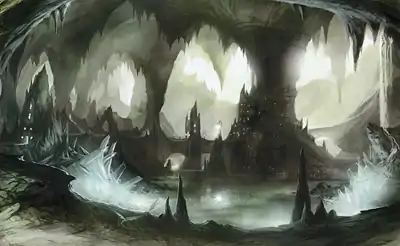Underdark Exploration (4e Variant Rule)
Underdark Exploration
The dark depths of the underdark is the perfect location to stage a spiderkind themed adventure. The underdark is the home of the drow, and is thus teeming with many varieties of spiderkind. It is also a popular destination for parties of adventurers with more wanderlust than sense. The underdark is, esentially, an underground labyrinth of deep caverns. This section contains rules for the exploration of the underdark (though it will easily work with any natural cave system). For more detailed information about the underdark, it is best to refer to underdark or books about real-world cave systems.
Light
As the underdark is, as its name suggests, dark, [[4e Index (4e Other)#light source|light sources]] are important to most adventurers (though not to the lucky few with [[4e Index (4e Other)#darkvision|darkvision]]!). However, in the depths of the underdark, carrying a light source is a risk, as light reveals your location to the denizens of the underdark.
Seeing Distant Light
Complete Darkness: In [[4e Index (4e Other)#darkness|darkness]], a light source can be spotted from a distance up to 20-times its radius of illumination. For example, a [[4e Index (4e Other)#sunrod|sunrod]] can be seen 400 squares away, while a candle can be seen 40 squares away. A light source can only be spotted from a distance 11 or more times its radius away with a [[4e Index (4e Other)#perception skill|perception]] [[4e Index (4e Other)#skill checks|check]] of DC 20.
Dim Light: In [[4e Index (4e Other)#dim light|dim light]], a light source can be spotted from a distance up to 10-times its radius of illumination. For example, a [[4e Index (4e Other)#sunrod|sunrod]] can be seen 200 squares away, while a candle can be seen 20 squares away. A light source can only be spotted from a distance 5 or more times its radius away with a perception check of DC 20.
Creatures outside the radius of illumiation, but close enough to the light source to see it automatically can see objects and creatures inside the light radius.
Spotting Distances
Often, line of sight will be blocked by natural formations in the underdark. When the party is travelling great distances, it is not easy to tell exactly how far they can see. In these cases, the table below can be used to randomly determine spotting distances in varous types of terrain.
| Terrain | Distance |
|---|---|
| Water-formed cave | 4d4 squares |
| Fungal Forest | 6d6 squares |
| Gorge or Shaft | 12d6 squares |
| Rift, Tunnel or Abyss | Limit of Sight* |
| * The radius of the party's light source. | |
Air
Many locations in the underdark have a poor air supply. With the exception of the rare creatures which do not need to beath, creatures and characters will be concerned about air supply in such places. Any area which is reasonably airtight can become stale or depeleted.
In general, a medium-size creature depletes a 2-square cube every 6 hours (a 1.6 square cube every hour), while a small creature needs half as much and a large creature needs four times more.
Stale Air: Areas with half of the normal amount of air are treated as areas with stale air. A creature or character in a region of stale air must make an endurance check each round (DC 10 + 1 per minute). If the character fails a check, the character becomes dazed. The character cannot recover from this dazed condition until it reaches an area of good air.
Depleted Air: Depleted areas become deadly in a matter of minutes. See [[4e Index (4e Other)#suffocation|suffocation]] on page 159 of the dungeon master's guide.
Climate
Some regions of the underdark are dangeously cold, such as pools of water and parts of the underdark too deep to receive warmth from the sun, but not deep enough to receive warmth from the core. In such areas, creatures and characters must make an [[4e Index (4e Other)#endurance skill|endurance]] [[4e Index (4e Other)#skill check|check]] every eight hours the character spends in such conditions (DC 22). A failure causes the creature or character to loose a [[4e Index (4e Other)#healing surges|healing surge]]. If the creature or character has no healing surges, then that creature or character takes [[4e Index (4e Other)#cold|cold]] or [[4e Index (4e Other)#fire|fire]] damage equal to its level.
Caving
When moving through cramped natural tunnels, it is much harder to fight effectively. The following rules represent the dificulty of combat in cramped quaters (smaller than half a creature or character's space in hight or width).
Cramped Spaces
Cramped spaces are split into the five categories below. When in one of the below categories of cramped spaces, a creature or character takes the penalties associated with that category, as shown on the table below.
Narrow or Low: A narrow or low space is a space less than half the height of the creature or character in height (low) or less than half the width of the creature or character's space in width (narrow).
Narrow and Low: A narrow and low space is a space that is less than half the creature or chartacter's height in height and less than half the width of the creature or characer's space in width.
Crawl-Navigable: A crawl-navigable space is a quarter of the creature or character's height in height.
Awkward Space: An awkward space is less than a quarter of the creature or character's height in height or less than a quarter of the width of the creature or character's space in width.
Tight Squeeze: A tight squeeze is an area larger than the creature's head, but smaller than its shoulders. Fighting iks impossible in such a space.
| Constriction1 | Move Penalty | Attack Penalty | Ranged weapon | |
|---|---|---|---|---|
| One-Handed | Two-Handed | |||
| Narrow or Low | 1/2 Speed | -2 | -6 | Any |
| Narrow and Low | 1/4 Speed | -4 | Unusable | Any |
| Crawl-Navigable | 1 Square | -8 | Unusable | Crossbow Only |
| Awkward Space | Acrobatics (DC 15)2 1 Square | -8 (light blade only) | Unusable | Crossbow Only |
| Tight Squeeze | Acrobatics (DC 15)2 1 Square | Unusable | Unusable | Hand Crossbow Only |
| 1. A creature moving through any constriction grants combat advantage to all of its enemies. 2. A creature moving through these constrictions must make an acrobatics check to move 1 square. | ||||
Rappeling
In the underdark, it may be necessary to descend quickly. This can be accomplished by rappeling. To rappel, a creature or character must use a [[4e Index (4e Other)#rope, hempen|rope]]. The creature or character can move down the rope a number of squares equal to the character's move speed as a [[4e Index (4e Other)#move action|move action]] with an [[4e Index (4e Other)#athletics skill|athletics]] [[4e Index (4e Other)#skill check|check]] to climb (a creature or character can replace their bonus to athletics with their bonus to [[4e Index (4e Other)#acrobatics|acrobatics]]) of DC 10. If the creature or character wishes to spend a double move action to move down the rope twice in one round, they instead make a single DC 20 athletics check (as above).
If the creature or character fails an athletics check, the creature or character falls. The creature or character can attempt to stop their fall as a move action. The creature or character takes an athletics check (as above). The DC is equal to 15 + 5 per previous check. On a success, the creature or character halts its movement, but takes 1d6 points of damage per 2 squares the character fell.
Back to Main Page → 4e Homebrew → Rules.
Back to Main Page → 4e Homebrew → Sourcebooks → Arachonomicon; the Book of Spiderkind → Campaigns.

